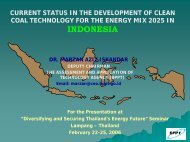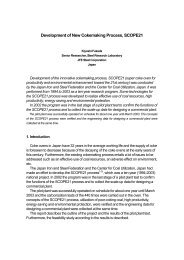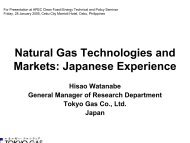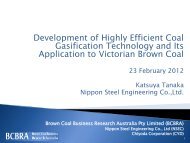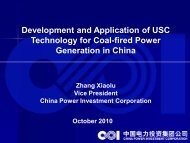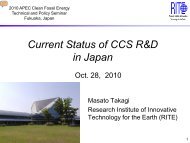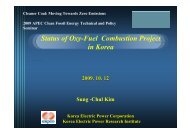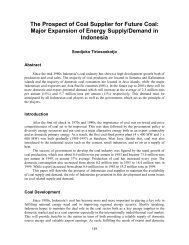Defining CCS Ready: An Approach to An International Definition
Defining CCS Ready: An Approach to An International Definition
Defining CCS Ready: An Approach to An International Definition
- No tags were found...
You also want an ePaper? Increase the reach of your titles
YUMPU automatically turns print PDFs into web optimized ePapers that Google loves.
Appendix B: Technology Design Options for a Capture <strong>Ready</strong> PlantAdvanced ShiftAs noted above, the classical shift setup with a high-temperature shift reac<strong>to</strong>r, cooler, andlow-temperature shift reac<strong>to</strong>r requires a considerable amount of steam. Several advancedshift setups have been proposed reducing this steam input. 149Improved CO 2 SeparationAs noted above, current technology for CO 2 separation involves solvents like those used fordesulphurization, working at low temperatures (up <strong>to</strong> 38°C) and requiring considerablesteam flows and pressure swings. A number of different CO 2 separation technologies areunder development, such as membranes and sorbents. Due <strong>to</strong> the larger size of CO 2molecules compared with hydrogen molecules, it is hard <strong>to</strong> develop membranes that arehighly selective <strong>to</strong> CO 2 (if CO 2 can get through the membrane, hydrogen usually can <strong>to</strong>o).Applying membranes or sorbents is expected <strong>to</strong> contribute <strong>to</strong> increased steam powergeneration and lower auxiliary power requirements. 150B.4 Technical Options for Capturing CO 2 from Industrial FacilitiesThis section presents the specific technical considerations for capturing CO 2 from thedifferent categories of industrial sources and the potential barriers <strong>to</strong> <strong>CCS</strong> Readiness.B.4.1 Nearly Pure CO 2 ProcessesThere are several industrial processes that produce an exhaust stream of nearly pure CO 2 .In such cases, the capture process can be great simplified <strong>to</strong> primarily compression of theCO 2 for transport. The primary processes of this type are hydrogen and ammoniaproduction and natural gas processing.Ammonia and Hydrogen ProductionHydrogen is produced for a variety of chemical processing applications, especially associatedwith hydrotreating <strong>to</strong> reduce the sulphur content of petroleum products. Hydrogen can beproduced at petroleum refineries or at separate facilities. Ammonia is used primarily forfertilizer, as well for some chemical processes. A much larger volume of ammonia is usedglobally compared with hydrogen, and ammonia is transported globally as a commoditychemical. Thus the volume of CO 2 associated with ammonia production is much larger thanthat associated with hydrogen production.For ammonia production, nitrogen and hydrogen are combined in an additional step <strong>to</strong>produce ammonia (NH 3 ). The hydrogen production steam reforming step is used in bothhydrogen and ammonia production and is the source of capturable CO 2 .The CO 2 must be removed from the process stream <strong>to</strong> produce pure hydrogen. There areseveral processes that are used <strong>to</strong> remove the hydrogen, which produce varyingconcentrations of CO 2 . The pressure swing adsorption (PSA) process produces a CO 2149 Carbo, M.C. et al. (2009). Steam demand reduction of water-gas shift reaction in IGCC power plants with pre-combustionCO2 capture. <strong>International</strong> Journal of Greenhouse Gas Control, 3, 712-719. doi:10.1016/j.ijggc.2009.08.003.150 U.S. Department of Energy, National Energy Technology Labora<strong>to</strong>ry (U.S. DOE-NETL). (2008c). Current and futureIGCC technologies (DOE/NETL Publication no. 2008/1337).23 February 2010 96



